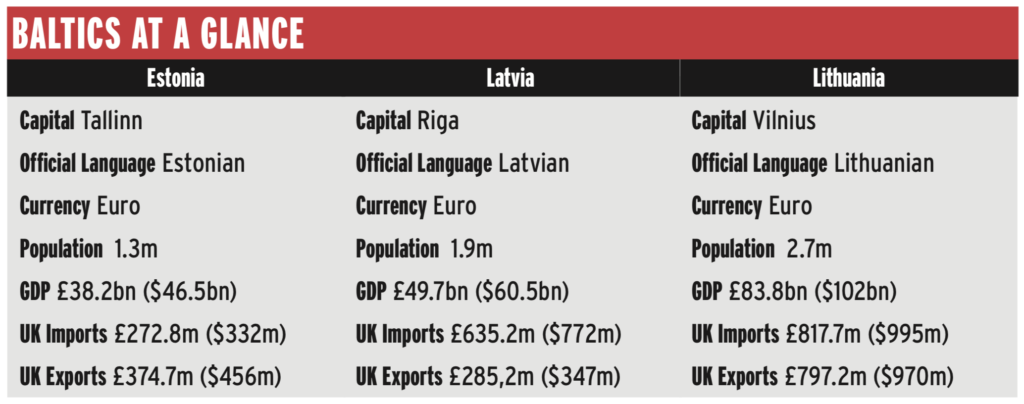Roger Williams heads east as he investigates the potential trading opportunities presented by the trio of Baltic nations

(© Waldkunst)
Three countries on the eastern coast of the Baltic Sea: Estonia, Latvia and Lithuania comprise the Baltic Countries. They are home to some six million people, some of whom must endure temperatures below freezing temperatures throughout the winter and rain up to every three days in the summer.
Small countries in land size, population and economy, in these measures they are comparable to Wales or a large county of England. The Baltic Countries have had years of population decline as citizens have gone on to find greener, warmer and richer pastures within the European Union.
All three countries were part of the USSR until their independence in 1990 and today, 900,000 of the population of the Baltic Countries speak Russian. The existence of ethnic Russian citizens has, following the annexation of the Crimea and the continuing conflict in the Ukraine, left the Baltic countries feeling threatened by Russia. The countries are all members of NATO and the EU which they joined in 2004.
The largest of the three Baltic Countries, both by population and area, is Lithuania. It is about a fifth bigger than Wales, with a slightly smaller population, some three million people.
Over a quarter of the country is forested. The country’s capital, Vilnius, houses some 542,000 people, which is about the same as Bradford in the UK.
Latvia is almost the same size as Lithuania but with around two-thirds of the population. It is more extensively forested than Lithuania, with over half of its land covered in trees.
Latvia’s capital city, Riga, is the most populous in the Baltic countries. It has 632,000 inhabitants, a third of the country’s population, and is comparable in population to Glasgow.
Estonia is the smallest of the three Baltic Countries at 17,462 square miles. Like Latvia, it is well-forested with an estimated 44 per cent of the land covered in trees. A third of the population live in its capital city, Tallinn, which is about the same size as Bristol.
All three Baltic Countries face a similar set of demographic problems: they have ageing populations and shrinking working-age populations. Migration to the richer countries in the EU has meant declines in their populations.
This has left a smaller working-age population to support a growing older pensioner population. Lithuania and Latvia have the highest rate of population decline in the EU. Smaller Estonia has managed to stabilise its population after years of decline.
In all three states, the solution that immigration offers is hampered by the importance of ethnicity to their citizens. The Baltics Countries demonstrate a strong protectionist, anti-immigrant, attitude toward their culture and identities due to their historical background.
Despite these demographic challenges, the Baltic Countries have seen around twice the annual percentage growth of the other EU countries in aggregate and remain forecast to continue to see four per cent annual growth or even higher in 2019. The economies of the Baltic Countries are small.
The largest economy is Lithuania’s at $53 billion. The UK GDP is 50 times bigger. Latvia’s 2018 GDP was $35 billion and Estonia’s was $30 billion. On a per capita basis GDP are respectively, $19,140; $18,032 and $22,990, around half that of the UK.
Estonia’s economy is the most advanced of the three Baltic countries and has been rated the ‘most advanced digital society in the world’ by the American magazine Wired.

The country can boast a literacy rate of 99.8 per cent. Its economy is boosted by an oil shale industry which is amongst the most developed in the world with over 80 per cent of the oil used extracted domestically.
This allows Estonia to be self-sufficient in power generation. Its industrial sector is nearly a third of its economy, producing: chemicals, electronics, machinery, ships, textiles, energy and timber.
In the Estonian services sector, telecommunications, transport and banking are all advanced and efficient. In terms of exports, electrical equipment is the largest category at $2.8 billion (16 per cent of total exports); mineral fuels including oil are second at $2.6 billion (14.7 per cent); then wood at $1.8 billion (10.1 per cent) and machinery including computers at $1.6 billion (8.7 per cent) The country’s main export partners are Finland, Sweden, Latvia, USA and Germany.
Latvia’s economy is not as an advanced as its next door neighbour Estonia, despite being the first of the three Baltic economies to industrialise. Today, its main industries are chemicals, textiles, processed foods, wood products and machinery.
Chemicals dominate exports with cosmetics, fibres and detergents playing a major part. Agriculture, although contributing less than four per cent to GDP, employs some eight per cent of the work force and uses around a third of the country’s land area.
Latvia exports principally wood and wood products, machinery and equipment, iron and steel, textiles and foodstuffs. Its main export destinations are Lithuania, Russia, Estonia, Germany and Sweden.
Lithuania, like Latvia has historically been a food producer and today it employs a similar percentage of the work force as in its neighbour, Latvia. Agriculture has led Lithuania to develop a wide range of processed food products. However, it is in financial technical services or FinTech that the country has placed its future hoping to become the FinTech hub for the EU.
Lithuania promises a fast track for European operational licenses for FinTech firms which cuts start-up times by up to 75 per cent. After the UK, Lithuania has issued the most e-money licences in the EU. The country could not have achieved this position without a large and established IT sector.
It is estimated that there are over 37,000 people employed in IT and the country is home to 13 of the 20 biggest IT firms in the Baltic countries. Barclays and Western Union have outsourcing operations in Lithuania. Google established a payment firm in Lithuania in 2018.
Lithuania’s top three exports are mineral fuels including oil ($5.1 billion); machinery including computers ($2.8 billion) and furniture, bedding, lighting, signs, prefab buildings ($2.5 billion). Over 80 per cent of Lithuanian exports by value were delivered to fellow European counties.
Exports are very important to all three Baltic countries. Latvia ranks 17th in the world when exports are measured as a percentage of GDP; Estonia ranks 19th and Latvia 32nd. To put this in perspective, Singapore ranks third and China 113th.
Lithuanian forests are full of wild animals including deer, wild bear, beaver, elk and many others. Hunting is allowed for elk, wild bear, wolves, foxes, hares and birds, including goose, duck and woodcock.
Hunting season starts in April, the busiest months for hunting are November, December and January. In Latvia, the most common quarry are red deer, roe deer and wild boar but you can hunt beaver and lynx and there are good populations of capercaillie and black grouse.

Estonia offers in addition to the Latvian quarry list, world-class moose hunting or lynx hunting, as well as deer hunting and brown bear and hazel grouse.
From the perspective of field sports, the Baltic countries offer well-established markets for all products. There are long used supply routes and distributor and retail networks are dominated by products from Germany, Poland, Czech Republic, Italy and Finland.
The countries are small but from the perspective of field sports demand and distribution, well-established and organised.






Comments are closed